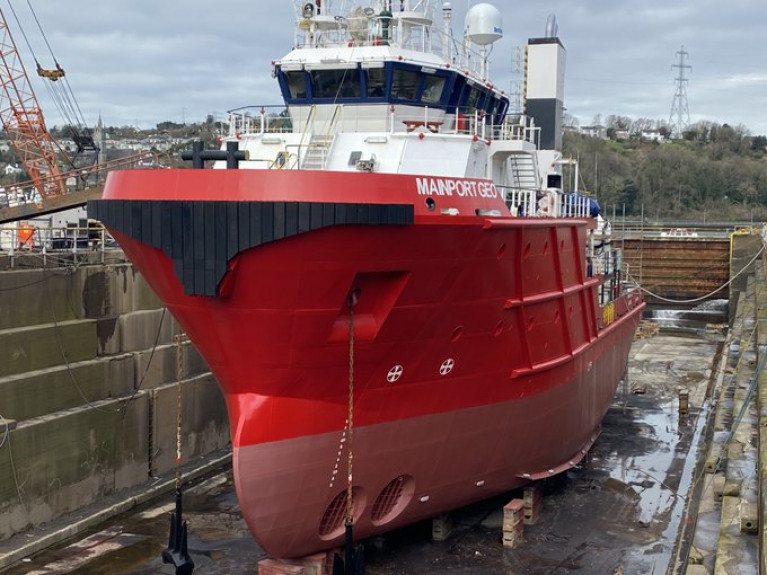Displaying items by tag: 'Converted' Ship
Cork Dockyard's completion to convert a Mainport Group offshore supply vessel acquired in Africa, as Afloat reported in January, is expected to see the ship depart drydock shortly, prior to a new role in the offshore renewables sector, writes Jehan Ashmore.
The Mainport Geo (formerly Oya), of 1,240 gross tonnage and which cost around €15m to build in 2015, had been operating for previous owners, with the 50m vessel based in the Ivory Coast.
The west African state was challenging to reach for Mainport given Covid-19 restrictions, but was to enable an inspection of the vessel last summer before making a delivery voyage to Cork Harbour.
As previously covered, the conversion took place at Doyle Shipping Group's (DSG) Cork Dockyard, so to transform Mainport Geo into a 'top-class survey vessel in the new year' according to the Group.
For more than 40 years, the group's main role has been to serve the Kinsale Gas Field, where operations are to end this year, that will lead platforms to be decommissioned.
The company also operates a subsidairy, Celtic Tugs on the Shannon and seismic ships for the global hydro-carbon industry, but is diversifying into the offshore renewables sector as 'Seascapes' last week also highlighted.
Mainport see the great potential of companies in developing wind-farms projects off the south and west Irish coasts. In addition international clients seeking such related survey/scientific ships have already led to interested players about the Mainport Geo coming from the North Sea but also to survey the seabed off Angola, also in west Africa.
To meet the requirements of such specialist ships, the conversion included a new mezzarine deck. This is to feature an Remotely Operated Vehicle (ROV) and a launch and recovery system (LARS) located on this new deck to deploy and retrieve the ROV.
To conduct survey work, a new port side crane was installed to handle an underwater survey baseline (USBL) pole. This difficult operation entailed marine engineering skills at Cork Dockyard (see Verolme shipbuilding era) to incorporate the techology by inserting 3m within the hull and to allow an outreach of a 1.5m survey pole positioned below the keel.
Also as part of the survey systems, involves the use of gliding multi-beams surveys, by using a blue pole also placed under base of the ship. These techologies map the sea bed structure and identify where suitable to install the base of wind-farm turbine towers.
As Afloat also previously mentioned, Mainport Geo is fitted with Dynamic Positioning (DP2-class) technology to enable the ship to maintain an exact stationary location while in deep seas, where conditions would not be possible with an anchor coupled with currents and waves.
The DP system is linked up with satellittes, where computers constantly monitor and adjust the ship's thrusters to pin-point accuracy where precision of seabed survey work can be maintained.
Unlike the rest of the Mainport fleet which have the company colours of a blue hull and white superstructure, Mainport Geo sports a red hull with the white forward deckhouse for 35 crew.
The reason for the red, cited Mainport was that the prior owner had intended to carry out the 5-year special ship survey and this involved purchase of red paint.
As such these paint drums remained on board and given the cost benefit, they were readily put to good use with the Munster based vessel so far, carrying aptly the same colours of the 'Rebel' county.
When Mainport Geo is floated off the stocks in Cork Dockyard, the ship will carry out trials at sea before the first constractor is secured leading to the ship's debut commercial deployment.





























































